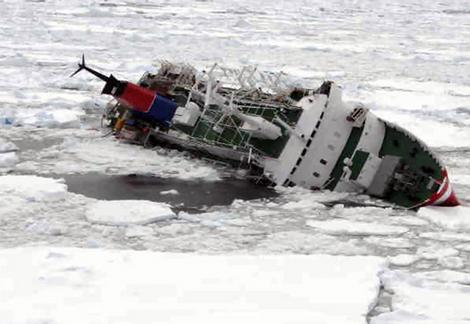The Arctic Circle Organization headquartered in Iceland held its first regional summit “The Alaskan Arctic Summit on Shipping and Ports” August 23-25, 2015 in Anchorage, Alaska. It’s the first in a series of issues-based forums The Arctic Circle Organization plans to hold around the world. The Summit was designed to build partnerships to develop safe and reliable shipping throughout the Alaskan Arctic. Public-Private partnerships will be needed to finance critical ports of refuge, search and rescue equipment, transshipment facilities and icebreakers in the Alaskan Arctic. The meeting also included panels of local and indigenous leaders from the Arctic presenting their interests as an integral part of any development planning. The Summit hosts were Alice Rogoff of Alaska Dispatch News, Icelandic President Olafur Ragnar Grimsson, and Mead Tredwell, former Alaska lieutenant governor.
In particular the Summit focused on:
- Developing safe and reliable shipping practices to protect the hunting and fishing activities of arctic residents and the environment
- Exploring public-private cooperation models to produce the necessary infrastructure investments
- Establishing a task force to offer global shippers a regular, safe and reliable shipping system
Moderator, Thomas P. Ostebo, retired commander of the US Coast Guard’s 17th District in Alaska opened the Summit. He reported that foreign flagships are showing up unannounced more and more in Alaska creating a growing need for increased monitoring and regulation of those ships and their activities in the Alaskan Arctic.
The Northern Sea Route: A Model of Public-Private Arctic Cooperation
As an example of safe and reliable shipping partnerships in the Arctic, Felix Tschudi, Chairman of the Norwegian Tschudi Group and Chair of the Centre for High North Logistics, presented the challenges, opportunities and successes of the Northern Sea Route (NSR). Tschudi Group is very active in north Norway both in Kirkenes and Svalbard and cross border with Russia in port development, oil transshipment, bulk terminals, and northern shipping logistics including cross-border transport. The Northern Sea Route extends from Kirkenes in northern Norway and Murmansk in Russia over the north coast of Russia to Alaska and south through the Bering Straight to Asia. Since 2010 use of the NSR has grown from 4 passages to Asia saving an average of 18 days (compared to the Suez Canal) to a high of 71 passages in 2013. Since then annual NSR passages have averaged in the low 50’s.
In the mid-term Mr. Tschudi expects regional destination shipping serving oil & gas development in Siberia and Alaska will be the most common uses of the opening Arctic shipping routes. According to Mr. Tschudi, the NSR “will offer tremendous savings in moving equipment between the Alaskan, Russian and Norwegian markets”. A recent increase in orders for new Liquefied Natural Gas (LNG) Carriers globally combined with the Yamal LNG plant being built in Sabetta, Russia will likely also result in increased Arctic transshipment of LNG from Russia to Europe and Asia. Increased shipping of frozen fish from Norway and Alaska to Europe and Asia is also expected due to Russian sanctions on fish imports expanding new markets. Mr. Tschudi does not anticipate large volume container shipping will grow in the Arctic mid-term.
According to Mr. Tschudi, successful arctic shipping depends on adequate infrastructure and there are many infrastructure projects that should be coordinated including arctic ports connected to railway hubs. He cautioned there are “several Arctics” with varying geographic, climatic, and demographic conditions and while Alaska has some similar challenges to Norway “one size does not fit all”. Mr. Tschudi also believes political will is needed to incentivize stakeholders to take advantage of joint Arctic opportunities.
Regarding emergency preparedness and cooperation, Mr. Tschudi pointed to the Russian mandated icebreaker escorts and accompanying regulatory requirements as a best practice to prevent accidents. The Arctic Council agreement on developing a joint international framework for Arctic search and rescue is also key to sustainable development in the Arctic. Mr. Tschudi also expects increased economic activity in the region will improve emergency preparedness and response due to increased availability of emergency vessels, equipment and personnel, provided necessary coordination is facilitated he emphasized.
The Future of US Arctic Navigation
Captain Scott J. Smith, Chief of the Office of Navigation Systems for the U.S. Coast Guard (USCG) reported on the future of US Arctic navigation. His office is responsible for policy and program oversight for marine spatial planning; vessel traffic services; visual aids to navigation (ATON); electronic aids to navigation; automated identification systems (AIS); marine safety information; and navigation rules and regulations.
Captain Smith discussed the USCG’s new Future of Navigation Initiative, an internet-based system the USCG is creating jointly with the US National Oceanic and Atmospheric Administration (NOAA); the U.S. Army Corps of Engineers, the National Ice Center; and the Marine Exchange of Alaska. The Future of Navigation Initiative will provide route planning and port information including maritime safety information (eMSI), and environmental and ice warnings, received by AIS (Automatic Identification System) Towers and existing AIS-ATON (Aids to Navigation physical, and in some cases virtual, buoys). The internet-based system is currently being tested on board the USCG Icebreaker HEALY receiving regular ice edge reports from Barrow, Alaska.
Author Linda Priebe is former Deputy General Counsel and Ethics Official at the White House Office of Drug Policy under three different presidents with over a dozen winning cases before the U.S. Supreme Court. She is also formerly Member of the Utah Solid and Hazardous Waste Control Board and Assistant Utah Attorney General for Indian Affairs. Linda is currently Chair of Government Relations at Culhane Meadows PLLC and Secretary of the Norwegian American Chamber of Commerce in Washington, DC. She can be reached at LPriebe@culhane.law.



